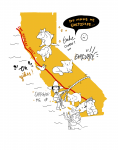With every tremble of the 7.1 Ridgecrest earthquake, many Californians wondered: “Is this going to be the Big One?”
To say that UCLA is in earthquake country is an understatement. With the Santa Monica Fault running through Westwood, the Newport-Inglewood Fault a stone’s throw away and the San Andreas Fault – the seismic giant – within striking distance, earthquakes are inescapable.
Despite this, earthquake preparation is rarely discussed among faculty and students.
Preparation for an earthquake is twofold: the physical gathering of supplies and the mental evacuation plan. Students are ready for neither. UCLA should help facilitate this planning and ensure that students at least consider the possibility of an earthquake before embarking on a four-year journey on potentially shaky ground.
“The ‘Big One’ is the terminology we use to refer to a magnitude 7.5 earthquake on the San Andreas Fault,” said earthquake expert and UCLA associate professor of geophysics Lingsen Meng. “Historically, we generally have big earthquakes in Los Angeles about every 100 to 180 years – the last one was in 1857.”
That being said, Southern California is well overdue for a Big One.
And when that time comes, there will be severe shaking, considerable damage and casualties in Los Angeles.
“We’re also not ready in terms of our infrastructure – it is not earthquake-proof,” said UCLA associate professor of civil and environmental engineering Scott Brandenberg.
In fact, many structures on campus are determined unsafe, such as Franz Hall, which is currently under construction, and Bunche Hall, a 12-story building held up by some stilts.
Building collapse is not the only outcome of an earthquake. There are often fires and gas leaks – not to mention being cut off from water supply, electricity, sewer systems and cellular networks.
And UCLA isn’t ready for such a disaster.
Brandenberg recommends that everyone have two weeks’ worth of water and canned food. But that could prove difficult for students living in the dorms and apartments, who can barely fit their belongings in the cramped living spaces – much less gallons of emergency water.
Brandenberg said that UCLA is responsible for a disaster plan, but faculty and staff are not trained about earthquake preparedness and protocol. According to Brandenberg, faculty receive annual training on sexual harassment, cybersecurity and lab safety, but general earthquake safety is left out of the mix.
And other University of California schools have done better. The UC Berkeley Office of Emergency Management is at least communicative with students about the necessity of emergency kits and general preparation.
Over 11,000 students live on the Hill, and those students rely on UCLA’s residence and dining halls for food and water.
But students cannot be expected to know what to do if their own leadership is keeping them in the dark. It is unclear whether UCLA will provide resources for students, or if students should store two weeks’ worth of food, water and iodine treatment kits in their dorm rooms.
“I don’t think UCLA is storing anywhere near the amount of water that would be needed,” said earthquake engineering expert and UCLA civil and environmental engineering professor Jonathan Stewart.
If students are expected to go into survival mode, it is a major oversight for UCLA not to prepare them for that. And with so little information given about what the plan is in an earthquake, students are left to wonder.
That is, if they even consider it.
Many students at UCLA who are out-of-state or international might have never experienced an earthquake before. And even California residents who are all too familiar with “Drop, Cover and Hold On” drills are ill-prepared for an earthquake.
Kaitlin Ryan, a rising fourth-year molecular, cell and developmental biology student experienced this firsthand at UCLA during the Ridgecrest earthquake.
“It was pretty crazy,” said Ryan, who was at her research lab. “I felt the building start to sway – it sounded like everyone opening and closing doors all at once and I started to see exit signs swaying and vents slightly opening.”
Although she grew up in California and has experienced earthquakes, Ryan said she does not store extra water and supplies in her apartment.
And preparation is not only physical, but also mental.
Emanuel Maidenberg, a clinical professor of psychiatry and biobehavioral sciences at the David Geffen School of Medicine and expert on the stress caused by natural disasters, said people can mentally prepare by walking through scenarios in their minds.
“The anxiety response is proportionate to the distance from the epicenter,” Maidenberg said.
While UCLA students might not feel much anxiety from the Ridgecrest earthquake due to the campus’s distance from the shaking, now is the time for UCLA leadership to step in and prepare students to prevent such anxiety when the epicenter is closer to Westwood.
Of course, preparing for an earthquake requires money, time and inconvenience – especially in the case of retrofitting buildings. But while the return on such preparations is not immediate, it would saves lives and millions of dollars in damaged infrastructure when the earthquake inevitably hits.
It typically takes a seismic event to jolt people’s attentions. In the aftermath of the Ridgecrest earthquake, UCLA can take advantage of this opportunity to eliminate any ambiguity and advise students on what actions they should take in the future.
Now isn’t the time to let earthquake safety slip through the cracks.

$5332 & $7354…….. Both of these paychecks I have got after my enrolling of an internet project approximately 2 months past. I am not skillful and not on-line professional but still I am capable of bring home 1000s per month. This work is incredibly effortless and also its regular earnings are splendid. Here’s what I do >>>> pagancanister.kann-helfen.de